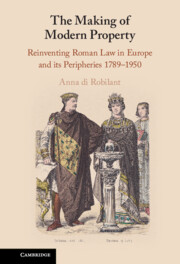Book contents
- The Making of Modern Property
- The Making of Modern Property
- Copyright page
- Dedication
- Contents
- Acknowledgments
- Introduction
- 1 What Roman Antiquity Had to Offer
- 2 The Foundations of Romanist-Bourgeois Property
- 3 Crafting Romanist-Bourgeois Property
- 4 Reform, Not Revolution
- 5 The Tensions of Absolute Property
- 6 Roman Dominium in the Republics of Latin America
- 7 The Social Critics
- Conclusions
- References
- Index
5 - The Tensions of Absolute Property
Published online by Cambridge University Press: 13 July 2023
- The Making of Modern Property
- The Making of Modern Property
- Copyright page
- Dedication
- Contents
- Acknowledgments
- Introduction
- 1 What Roman Antiquity Had to Offer
- 2 The Foundations of Romanist-Bourgeois Property
- 3 Crafting Romanist-Bourgeois Property
- 4 Reform, Not Revolution
- 5 The Tensions of Absolute Property
- 6 Roman Dominium in the Republics of Latin America
- 7 The Social Critics
- Conclusions
- References
- Index
Summary
The nineteenth-century theorists of modern Romanist dominium, the great French treatise writers and the German Romanists, embarked in a quest for coherence, aspiring to develop a body of property law that was both normatively and conceptually coherent. These jurists sought to build an architecture of logically interrelated property doctrines informed by the unifying commitment to maximizing the owner’s freedom of action. Yet, this coherence was illusory. Far from being coherent, modern property was riven with tensions that could hardly be disguised. This chapter examines the jurists’ attempts to deal with four doctrines that threatened to strain the coherence of the property system: emphyteusis, possession, the limits on ownership and common ownership. While ultimately unsuccessful, these attempts are nonetheless worth exploring. For one thing, these failed attempts opened rifts in the apparently solid edifice of modern dominium, rifts that, a couple of decades later, the social critics will be quick to exploit. Most importantly, the jurists’ efforts to ease these tensions throw into sharp relief a diversity of ideological and methodological views that hardly surfaces in the nineteenth-century property treatises.
Keywords
- Type
- Chapter
- Information
- The Making of Modern PropertyReinventing Roman Law in Europe and its Peripheries 1789–1950, pp. 204 - 234Publisher: Cambridge University PressPrint publication year: 2023



